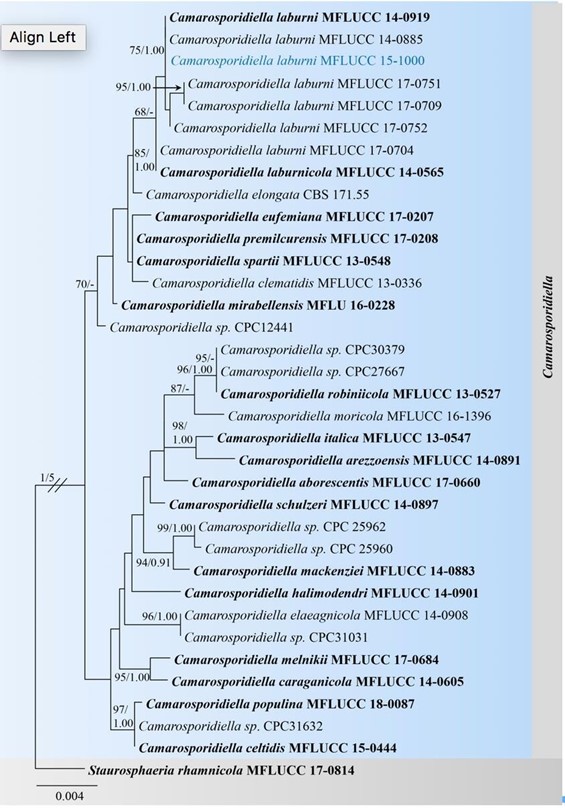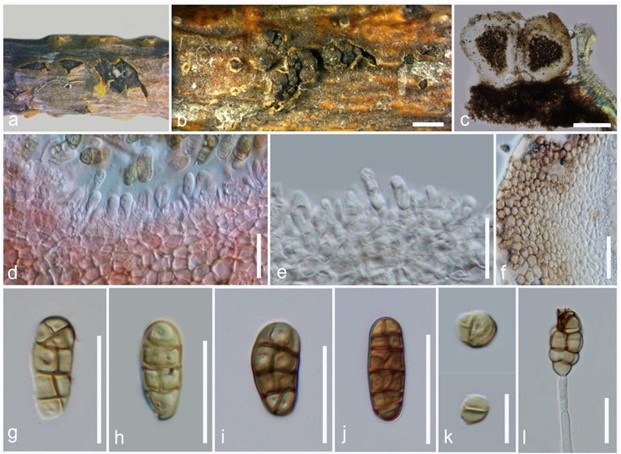Camarosporidiella laburni (Pers.) Wanas., Bulgakov, Camporesi & K.D. Hyde, Stud. Mycol. 87: 233 (2017). Fig. 60
≡ Sphaeria laburni Pers., Observ. mycol. (Lipsiae) 1: 68 (1796).
MycoBank number: MB 821952; Index Fungorum number: IF 821952; Facesoffungi number: FoF 03540;
Saprobic Sexual morph: Undetermined. Asexual morph: Conidiomata pycnidial, 340–435 µm high, 300–430 µm diam. (x̅ = 398 × 313 µm, n = 10), solitary or gregarious, black, immersed, sometimes scattered beneath the host periderm or on decorticated wood, fully or partly erumpent, unilocular, with a papillate ostiolate. Ostiole central, ostiolar canal filled with hyaline or pale brown cells. Conidiomatal wall multi-layered, 37–95 µm wide, thick, comprising 10–15 layers, outer layers heavily pigmented, thin-walled, comprising blackish to dark reddish-brown cells of textura angularis, cells towards the inside lighter, inner layer composed of 6–8 layers of hyaline, thik- walled cells of textura angularis. Conidiophores 2.6–7.8 × 1.3–2.5 µm (x̅ = 4.6 × 1.8 µm, n = 20) reduced to conidiogenous cells. Conidiogenous cells enteroblastic, annellidic, doliiform, integrated, solitary, hyaline, smooth-walled, and immerged from the inner layer of pycnidium wall. Conidia 13–22 × 6–11 µm (x̅ = 18 × 7.7 µm, n = 20), oval, straight to slightly curved, rounded at both ends, pale brown to brown, muriform, 4–5-transverse septate, with 1–2-longitudinal septa per each cell, smooth-walled.
Material examined – Russia, Rostov region, Rostov-on-Don city, territory of Southern Federal University, parkland, on dead branches (with signs of necrosis) of Caragana arborescens Lam. (Fabaceae), 23 April 2015, Timur S. Bulgakov, T-412 (MFLU 15-2116); living culture MFLUCC 15-1000.
Notes – Our new isolate (MFLUCC 15-1000) clustered within other Camarosporidiella laburni strains in the phylogenetic tree (Fig. 59). Differences of two bases were noted in the ITS region between our new isolate and the ex-type (MFLUCC 14-019). The new collection is similar to the holotype of C. laburni (Wanasinghe et al. 2017a). By considering the morphological and molecular data we designate our new collection as C. laburni, which is the first record from Caragana arborescens.

Figure 59 – Phylogram generated from maximum likelihood analysis (RAxML) of Camarosporidiellaceae based on ITS, LSU, SSU, and tef1 sequence data. Maximum likelihood bootstrap values equal or above 70 %, Bayesian posterior probabilities equal or above 0.90 (MLBS/PP) are given at the nodes. Isolate/specimen number is noted after the species name. The tree is rooted to Staurosphaeria rhamnicola (MFLUCC 17-0814). The ex-type strains are indicated in bold. Newly sequence is in blue. Hyphen (-) represents support values below 70 % MLBS and 0.90 PP.

Figure 60 – Camarosporidiella laburni (MFLU 15-2116). a Herbarium specimen. b Conidiomata on the host substrate. c Section through conidimata. d, e Conidia attached to conidiogenous cells. f Section through conidiomatal wall. g–k Conidia (k upper view). l Germinating conidia. Scale bars: b = 1 mm, c = 200 µm, d = 100 µm, g = 50 µm, e, f, h–k = 20 µm, m = 20 µm, l = 10 µm.
